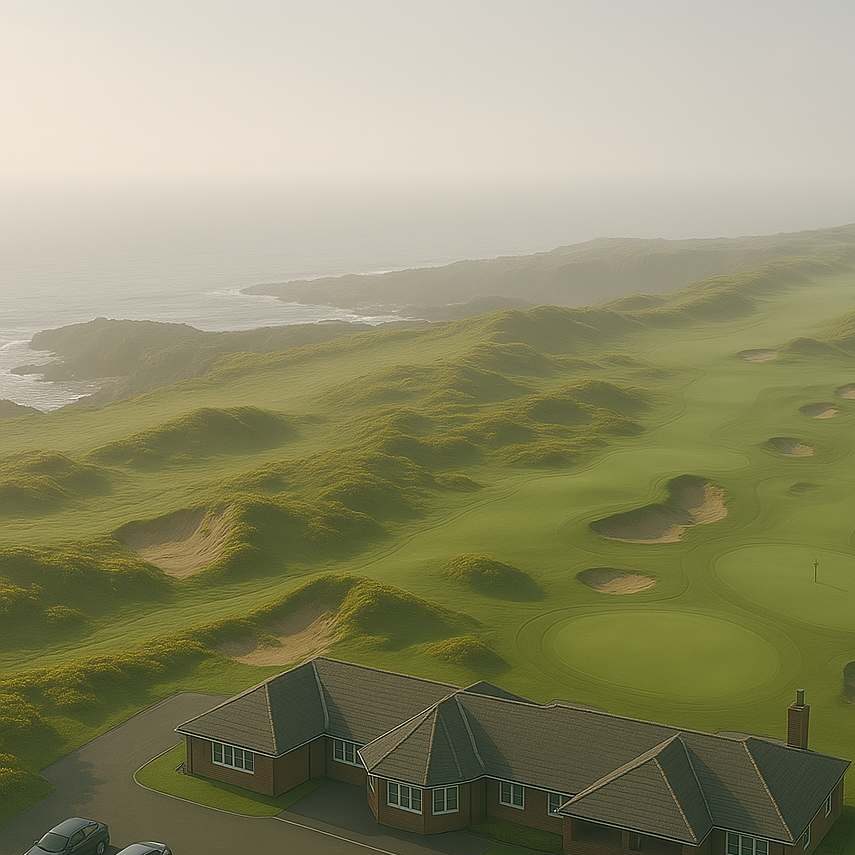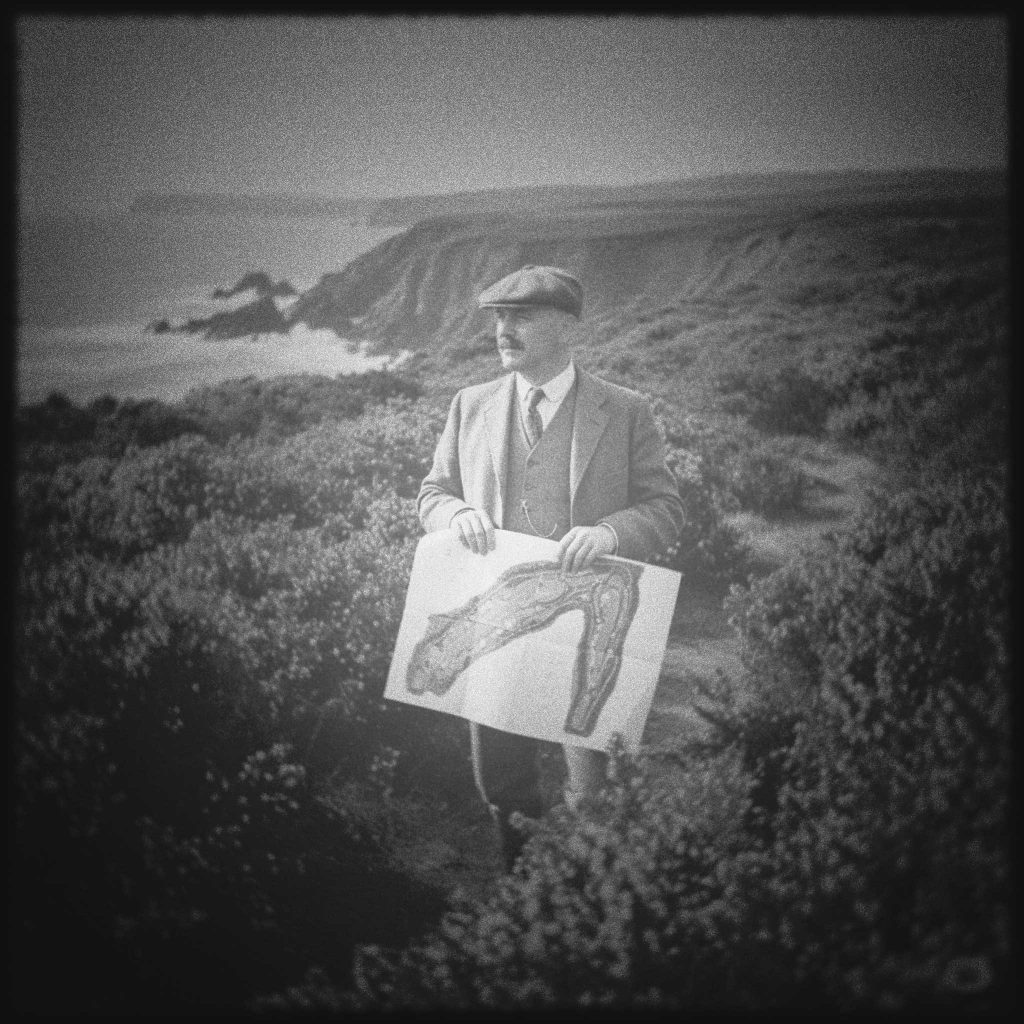A Modern Testament to Timeless Tradition

- Introduction: The Call of the North Sea
- Section I: A History Forged by Land and Sea
- Section II: The Measure of the Links: Course & Slope Ratings
- Section III: The Official Scorecard of the AI Golf Links
- Section IV: A Hole-by-Hole Pilgrimage
- Conclusion: The Enduring Challenge
Introduction: The Call of the North Sea

On the rugged Northumbrian coast of England, where the ruins of Dunstanburgh Castle stand sentinel against the relentless North Sea, lies a stretch of land seemingly forgotten by time. This is the home of The GCI Golf Links, a golf course design that offers not just a game, but a pilgrimage to the very soul of golf. Here, the air is thick with the scent of salt and the cry of gulls, and the landscape is a raw tapestry of towering dunes crowned with swaying marram grass. The ever-present wind, sweeping in from the sea, is not merely a condition but an architect, constantly shaping the land and the strategies of those who challenge it.
The ethos of The GCI Golf Links golf course design is one of authenticity. It is a “true links,” a term reserved for courses born of the coastal strips of sandy, barren soil from which the sea has retired. This is not a manicured parkland course with lush, tree-lined fairways; it is a natural, elemental test where the ground is as much a factor as the air. In the spirit of the game’s most revered venues, such as the Old Course at St Andrews, The GCI Golf Links is a public course, open to all who wish to experience golf in its purest form.
A round here represents the “heart and soul of the sport,” a place where modern, sustainable stewardship meets timeless golf course design principles. It is a course that demands creativity, strategic thinking, and a humble acceptance of the bounces, both kind and cruel, that the game provides. The GCI Golf Links offers an unforgettable challenge that rewards thoughtful shot-making and a deep appreciation for the natural contours of the land over sheer power.
Section I: A History Forged by Land and Sea
The story of The GCI Golf Links is inextricably linked to the land itself. Its origins lie in the hlincas—the Old English word for the rising ground and ridges that define this unique coastal topography. For centuries, this strip of land was deemed worthless for agriculture; its sandy, porous soil could not support crops, making it fit only for the grazing of sheep and the burrowing of rabbits. Yet, this very barrenness made it the perfect incubator for the game of golf. The hardy, indigenous fescue and bentgrasses that thrived in these conditions created a firm, fast-playing turf, and the natural drainage of the sandy base meant the ground was playable nearly year-round, even after heavy rains. This unique environment is the fundamental reason the course plays as it does, dictating a “running game” where players use the firm ground as an ally rather than an obstacle.
Design Inspiration

The course was given its formal layout in the early 20th century, during the “Golden Age” of golf course design and architecture. The club commissioned Alistair MacKendrick, a (fictional) visionary Scottish designer and contemporary of legends like Harry Colt and James Braid. MacKendrick’s philosophy was one of minimal intervention. He believed a great course was not built upon the land, but rather “found” within it. With only rudimentary tools and manual labor at his disposal, he followed the natural contours of the dunes, crafting holes that flowed through existing hollows and over ridges. He laid out the course in the classic “nine out, nine in” routing, a design born of necessity on the narrow strips of linksland, which takes players away from the clubhouse along the coast for the front nine before turning them back toward home for the inward journey.
Today, the stewardship of The GCI Golf Links honors MacKendrick’s vision while embracing modern responsibility. The course is managed with a profound respect for its fragile ecosystem, operating in a manner similar to Royal County Down, which lies within the Murlough Nature Reserve. The club employs a suite of sustainable greenkeeping technologies to preserve the natural character of the links. Lightweight, all-electric mowers are used to minimize compaction on the sandy soil, and a smart irrigation system provides precise, targeted watering to maintain the health of the fescue and bentgrass turf without unnecessary waste. This commitment ensures that the firm, fast fairways and true-rolling greens that define the links experience are preserved for generations to come, maintaining a delicate balance between a championship-level playing surface and ecological integrity.
Section II: The Measure of the Links: Course & Slope Ratings

To quantify the unique challenge presented by the GCI Golf Links, the golf course design has been meticulously rated under the World Handicap System. The USGA Course Rating is far more than a simple measure of yardage; it is a complex evaluation of the playing difficulty for a scratch golfer, taking into account ten distinct obstacle factors on every hole. These include topography, fairway width, recoverability from the rough, bunkers, green surfaces, and even a psychological component that assesses the intimidation factor of certain shots.
The Slope Rating, meanwhile, measures the relative difficulty of the course for a bogey golfer compared to a scratch golfer. On a true links course, this differential can be dramatic. The very features that define the experience—unpredictable winds, firm turf that can propel a slightly errant shot into a deep pot bunker, and forced carries over swathes of thick gorse—tend to punish the higher-handicap player more severely than the elite player. A scratch golfer may have the skill to fly a pot bunker or keep the ball low under the wind, whereas a bogey golfer may find these same hazards to be score-wrecking obstacles. This disparity is why The GCI Golf Links carries a high Slope Rating, reflecting that the challenge escalates quickly for the average player. The ratings for each set of tees have been carefully calculated to reflect these inherent difficulties.
Course & Slope Ratings by Tee
| Tee Box | Color | Total Yardage | Course Rating (Men) | Slope Rating (Men) | Course Rating (Women) | Slope Rating (Women) |
| Championship | Black | 7,015 | 74.2 | 142 | N/A | N/A |
| Medal | White | 6,050 | 70.1 | 132 | 75.4 | 138 |
| Senior/ Intermediate | Yellow | 5,580 | 67.8 | 125 | 72.9 | 131 |
| Ladies/ Forward | Red | 5,120 | N/A | N/A | 70.1 | 126 |
| Junior | Green | 3,600 | N/A | N/A | 62.5 | 105 |
Section III: The Official Scorecard of the AI Golf Links
The scorecard for The GCI Golf Links is more than a tool for recording scores; it is a guide to the strategic heart of the course. A key feature is the Men’s Stroke Index (S.I.), which allocates handicap strokes for match play and other formats. It is a common misconception that the Stroke Index is a simple ranking of the holes from hardest (1) to easiest (18). While overall difficulty is the starting point, the final allocation follows specific recommendations from the World Handicap System (WHS) designed to ensure fairness in match play.
The allocation methodology is strategic. First, a raw difficulty ranking of each hole is generated using course rating data. Then, to ensure an equitable distribution of strokes throughout a match, the odd-numbered stroke indexes are assigned to the front nine and the even-numbered indexes to the back nine. Furthermore, to prevent matches from being decided too early, the lowest-indexed holes (1 through 4) are placed in the middle “triad” of each nine (holes 4-6 and 13-15), avoiding the beginning or end of each side. This careful process ensures that players receiving strokes have the opportunity to use them at pivotal moments in a round, reflecting a professional approach to course administration and competition management.
The Official Scorecard of the GCI Golf Links
| Hole | Name | Par | Black | White | Yellow | Red | Green | Index |
| 1 | First Light | 4 | 395 | 365 | 340 | 320 | 225 | 11 |
| 2 | The Plateau | 4 | 430 | 390 | 365 | 345 | 240 | 5 |
| 3 | Gorse Bend | 3 | 175 | 155 | 140 | 125 | 90 | 15 |
| 4 | MacKendrick’s Fold | 5 | 540 | 510 | 480 | 450 | 310 | 9 |
| 5 | The Shelf | 4 | 455 | 425 | 400 | 370 | 260 | 3 |
| 6 | Punchbowl | 3 | 160 | 140 | 125 | 110 | 80 | 17 |
| 7 | Dune’s Shadow | 4 | 410 | 380 | 355 | 325 | 230 | 1 |
| 8 | Long View | 5 | 565 | 530 | 505 | 470 | 330 | 13 |
| 9 | Halfway House | 4 | 400 | 370 | 345 | 315 | 220 | 7 |
| OUT | – | 36 | 3530 | 3265 | 3060 | 2830 | 1985 | – |
| 10 | The Turn | 4 | 385 | 355 | 330 | 305 | 215 | 12 |
| 11 | The Narrows | 4 | 440 | 405 | 380 | 350 | 250 | 4 |
| 12 | Shipwreck | 3 | 215 | 185 | 160 | 140 | 105 | 16 |
| 13 | Calamity | 4 | 425 | 395 | 370 | 340 | 245 | 6 |
| 14 | The Wrecker | 4 | 475 | 440 | 410 | 385 | 270 | 2 |
| 15 | The Dell | 4 | 370 | 340 | 315 | 290 | 205 | 14 |
| 16 | High Road | 3 | 190 | 165 | 145 | 125 | 95 | 10 |
| 17 | Purgatory | 5 | 515 | 485 | 460 | 430 | 300 | 8 |
| 18 | Home | 4 | 470 | 410 | 385 | 355 | 230 | 18 |
| IN | – | 35 | 3485 | 2775 | 2525 | 2290 | 1620 | – |
| TOT | – | 71 | 7015 | 6040 | 5585 | 5120 | 3605 | – |
Become a Course Strategist on the GCI Golf Links
Get a complete hole-by-hole, shot-by-shot strategy guide for this course, personalized for your game, in one of our Course Strategist Strategy Guides
Section IV: A Hole-by-Hole Pilgrimage
A round at The GCI Golf Links is a journey through the full spectrum of challenges that links golf course design can offer. The course is laid out as two distinct nines, each with its own character dictated by its relationship with the land and the prevailing wind.
The Outward Nine: A Battle with the Elements
The front nine heads north along the coastline, typically playing into or across the prevailing westerly wind, demanding control and precision from the very first shot.
- Hole 1: First Light (Par 4, S.I. 11)
- Layout: A gentle opening hole to ease you into the round, but only if you are precise. The fairway is wide but features subtle undulations that can kick an offline shot into the wispy fescue rough.
- Hazards: Two pot bunkers guard the left side of the fairway in the landing area, while a single bunker protects the front-right of the green.
- Green: Large and relatively flat, but very firm. The ideal shot is a low-running approach that uses the ground to roll onto the putting surface.

- Hole 2: The Plateau (Par 4, S.I. 5)
- Layout: A strong par 4 that doglegs slightly right. The tee shot must carry a patch of gorse to a fairway that slopes from left to right, toward the sea.
- Elevation: The green is perched on a natural plateau, making the approach shot play a club longer than the yardage suggests.
- Green: Slopes severely from back to front. Anything long will leave a treacherous, downhill putt.
- Hole 3: Gorse Bend (Par 3, S.I. 15)
- Layout: A beautiful but dangerous short hole. The green is nestled in a natural amphitheater of dunes, but is surrounded by thick gorse bushes.
- Hazards: Miss the green, and you are likely reloading. The wind often swirls in this corner of the property, making club selection difficult.
- Green: Small and kidney-shaped, with a pronounced ridge running through its center.

- Hole 4: MacKendrick’s Fold (Par 5, S.I. 9)
- Layout: The first par 5 offers a genuine birdie opportunity. The hole plays through a valley between two large dunes, or a “fold” in the landscape.
- Hazards: The driving area is pinched by dunes on both sides, and a series of cross-bunkers must be navigated on the second shot if you’re trying to reach in two.
- Green: A long, narrow green that is receptive to a well-struck long iron or fairway wood.
- Hole 5: The Shelf (Par 4, S.I. 3)
- Layout: A brute of a par 4 playing into the wind. The fairway sits on a narrow “shelf” of land with a steep drop-off to the right.
- Hazards: Out of bounds runs the entire right side. Deep pot bunkers protect the left side of the landing area and the front-left of the green.
- Green: Domed and firm, designed to “reject any shot lacking conviction”. Only a perfectly judged shot will hold the surface.
- Hole 6: Punchbowl (Par 3, S.I. 17)
- Layout: A classic links par 3 with a blind tee shot to a green hidden in a hollow. Aim for the marker post and trust the architect.
- Elevation: The tee is below the level of the green, adding to the uncertainty.
- Green: A true “punchbowl” green. Any shot that finds the putting surface will funnel toward the center, offering a chance at birdie.
- Hole 7: Dune’s Shadow (Par 4, S.I. 1)
- Layout: The toughest hole on the front nine. A blind tee shot must be played over the shoulder of a massive dune to a fairway that turns sharply left.
- Psychology: The blind tee shot and the hole’s reputation create significant mental pressure. A par here feels like a birdie.
- Green: Small, undulating, and guarded by three deep, “bearded” bunkers with overhanging lips of fescue.
- Hole 8: Long View (Par 5, S.I. 13)
- Layout: The longest hole on the course, offering spectacular views from its elevated tee. The fairway tumbles down into a valley before rising again to the green.
- Hazards: This hole is defined by its vast, sandy waste areas on either side of the fairway.
- Green: The largest green on the course, but with three distinct tiers, making long putting a supreme test of skill.
- Hole 9: Halfway House (Par 4, S.I. 7)
- Layout: A strategic par 4 that brings you back toward the clubhouse split by a central bunker complex, forcing you to make a choice off the tee.
- Hazards: Playing left of the bunkers leaves a shorter but blind approach. Playing right offers a clear view but a longer shot in.
- Green: A tricky, two-tiered green that slopes away from the player.
The Inward Nine: The Strategic Return Home
The golf course design of the back nine turns for home, with the prevailing wind now typically at the player’s back, bringing different hazards and strategies into play.
- Hole 10: The Turn (Par 4, S.I. 12)
- Layout: A dogleg left where the downwind conditions tempt long hitters to cut the corner over a cluster of pot bunkers.
- Strategy: The safe play is an iron to the corner, leaving a short iron in. The aggressive play brings eagle into the picture, but also double bogey.
- Green: Wide but shallow, demanding precise distance control on the approach.
- Hole 11: The Narrows (Par 4, S.I. 4)
- Layout: A long, straight par 4 where the fairway gets progressively narrower the closer you get to the green.
- Hazards: Dense gorse and fescue rough squeeze the landing area for the tee shot, placing a premium on accuracy.
- Green: Guarded by deep bunkers on both sides, requiring an aerial approach.

- Hole 12: Shipwreck (Par 3, S.I. 16)
- Layout: The longest par 3 on the course, fully exposed to the wind. The green is set against the backdrop of the sea, with the rusted remains of a (fictional) shipwreck visible at low tide.
- Psychology: The length, exposure to wind, and visually intimidating backdrop make this a daunting tee shot.
- Green: A huge, undulating green. A two-putt from long range is a significant achievement.
- Hole 13: Calamity (Par 4, S.I. 6)
- Layout: Inspired by the famous hole at Royal Portrush, this hole requires a heroic tee shot over a deep chasm filled with gorse and rocks to find the fairway.
- Hazards: There is no bailout; it is all carry. Anything you hit short is lost.
- Green: Set at an angle to the fairway and protected by a steep run-off area to the right.

- Hole 14: The Wrecker (Par 4, S.I. 2)
- Layout: The most difficult hole on the course. A long, demanding par 4 that doglegs slightly left around a massive dune complex, often playing back into a crosswind.
- Hazards: Thick, wiry gorse lines the entire left side, with an ancient stone wall marking out-of-bounds deep and right. Two deep pot bunkers guard the right side of the fairway landing area.
- Green: A large, heavily undulating green divided into two tiers by a sharp ridge. It slopes significantly from back to front, making any putt from above the hole terrifyingly fast.
- Hole 15: The Dell (Par 4, S.I. 14)
- Layout: A short, drivable par 4 for the longest hitters, playing downwind, hidden from the tee in a natural hollow, or “dell.”
- Strategy: Risk-reward is the theme. A bold tee shot can yield an eagle putt, but a miss will find one of the five deep bunkers surrounding the green.
- Green: Small and bowl-shaped, but with subtle internal contours that make short putts tricky.
- Hole 16: High Road (Par 3, S.I. 10)
- Layout: A stunning par 3 played along the cliff edge. The green is long and narrow, perched on a ridge with the sea to the right.
- Hazards: Anything pushed right will fall toward the beach. Bunkers guard the left side, the only safe miss.
- Green: Slopes from left to right, toward the sea, making every putt break more than it appears.
- Hole 17: Purgatory (Par 5, S.I. 8)

- Layout: A reachable par 5 with a fairway riddled with hazards. A deep burn (stream) crosses the fairway twice, creating a “purgatory” for those who misjudge their layup or attempt to go for the green in two.
- Strategy: Three good shots are the sensible play. Two heroic shots are the memorable one.
- Green: Protected in front by the burn and on the sides by steep, grassy mounds.
- Hole 18: Home (Par 4, S.I. 18)
- Layout: A majestic finishing hole playing back toward the iconic clubhouse. The fairway is wide and inviting, offering one last chance for a closing birdie.
- Hazards: The primary defense is a large, undulating green surrounded by collection areas, reminiscent of the “Valley of Sin” at St Andrews.
- Green: A massive, complex green with multiple plateaus and hollows. Getting down in two putts is a fine end to the round.
Conclusion: The Enduring Challenge
The GCI Golf Links stands as a testament to the enduring principles of the game. It is a golf course design that embodies the truest spirit of golf: a natural, strategic, and unpredictable test where no two rounds are ever the same. The synthesis of its history, the natural attributes of the hlincas land, and a design philosophy of minimal intervention has produced a layout that challenges every facet of a golfer’s ability.
A round here is more than a simple measure of a final score; it is an immersive experience. It tests a player’s creativity, patience, and ability to adapt to the “unpredictable conditions” that are the hallmark of coastal golf. Success at The GCI Golf Links belongs not to the player who simply hits the ball the farthest, but to the one who can master the low, controlled shot to cheat the wind, use the firm ground to their advantage, and accept the occasional cruel bounce as an integral part of the game’s soul. It is a pilgrimage for any student of golf, a publicly accessible course that delivers a world-class challenge and forges a genuine connection to the very origins of the sport.

0 Comments